TP-Link ADSL2, AC1750, D7 User Manual

Archer D7
User Guide
AC1750 Wireless Dual Band Gigabit
ADSL2+ Modem Router
REV2.0.0 1910011480
Contents
About This Guide. . . . . . . . . . . . . . . . . . . . . . . . . . . . . . . . . . . . . . . . . . . . . . . . . . . 1 Chapter 1. Get to Know About Your Modem Router. . . . . . . . . . . . . . . . . . 2
1. 1. Product Overview . . . . . . . . . . . . . . . . . . . . . . . . . . . . . . . . . . . . . . . . . . . . . . . . . . . . . . . . . . 3
1. 2. Main Features . . . . . . . . . . . . . . . . . . . . . . . . . . . . . . . . . . . . . . . . . . . . . . . . . . . . . . . . . . . . . . 4
1. 3. Panel Layout. . . . . . . . . . . . . . . . . . . . . . . . . . . . . . . . . . . . . . . . . . . . . . . . . . . . . . . . . . . . . . . . 5
1. 3. 1.Top View . . . . . . . . . . . . . . . . . . . . . . . . . . . . . . . . . . . . . . . . . . . . . . . . . . . . . . . . . . . . . 5
1. 3. 2.The Back Panel . . . . . . . . . . . . . . . . . . . . . . . . . . . . . . . . . . . . . . . . . . . . . . . . . . . . . . . 7
Chapter 2. Connect the Hardware . . . . . . . . . . . . . . . . . . . . . . . . . . . . . . . . . . 8
2. 1. Position Your Modem Router . . . . . . . . . . . . . . . . . . . . . . . . . . . . . . . . . . . . . . . . . . . . . . . . 9 2. 2. Connect Your Modem Router. . . . . . . . . . . . . . . . . . . . . . . . . . . . . . . . . . . . . . . . . . . . . . . . 9
Chapter 3. Log into Your Modem Router . . . . . . . . . . . . . . . . . . . . . . . . . . .12 Chapter 4. Set Up Internet Connections. . . . . . . . . . . . . . . . . . . . . . . . . . . .14
4. 1. Use Quick Setup Wizard . . . . . . . . . . . . . . . . . . . . . . . . . . . . . . . . . . . . . . . . . . . . . . . . . . . .15 4. 2. Manually Set up an Internet Connection . . . . . . . . . . . . . . . . . . . . . . . . . . . . . . . . . . . .15 4. 3. Set up an IPv6 Connection . . . . . . . . . . . . . . . . . . . . . . . . . . . . . . . . . . . . . . . . . . . . . . . . .16 4. 4. Test Internet Connectivity . . . . . . . . . . . . . . . . . . . . . . . . . . . . . . . . . . . . . . . . . . . . . . . . . .17
Chapter 5. Bandwidth Control. . . . . . . . . . . . . . . . . . . . . . . . . . . . . . . . . . . . .19
Chapter 6. Network Security . . . . . . . . . . . . . . . . . . . . . . . . . . . . . . . . . . . . . .23
6. 1. MAC Filtering . . . . . . . . . . . . . . . . . . . . . . . . . . . . . . . . . . . . . . . . . . . . . . . . . . . . . . . . . . . . . .24
6. 2. Access Control . . . . . . . . . . . . . . . . . . . . . . . . . . . . . . . . . . . . . . . . . . . . . . . . . . . . . . . . . . . . .25
6. 3. IP & MAC Binding . . . . . . . . . . . . . . . . . . . . . . . . . . . . . . . . . . . . . . . . . . . . . . . . . . . . . . . . . .27
Chapter 7. IPTV. . . . . . . . . . . . . . . . . . . . . . . . . . . . . . . . . . . . . . . . . . . . . . . . . . .29
Chapter 8. USB Settings. . . . . . . . . . . . . . . . . . . . . . . . . . . . . . . . . . . . . . . . . . .31
8. 1. Local Storage Sharing . . . . . . . . . . . . . . . . . . . . . . . . . . . . . . . . . . . . . . . . . . . . . . . . . . . . . .32 8. 1. 1.Access the USB disk. . . . . . . . . . . . . . . . . . . . . . . . . . . . . . . . . . . . . . . . . . . . . . . . . .32
8. 1. 2.Customize Your Settings . . . . . . . . . . . . . . . . . . . . . . . . . . . . . . . . . . . . . . . . . . . . .34 8. 2. Remote Access via FTP Server . . . . . . . . . . . . . . . . . . . . . . . . . . . . . . . . . . . . . . . . . . . . . .38 8. 2. 1.Access the USB disk. . . . . . . . . . . . . . . . . . . . . . . . . . . . . . . . . . . . . . . . . . . . . . . . . .38 8. 2. 2.Customize Your Settings . . . . . . . . . . . . . . . . . . . . . . . . . . . . . . . . . . . . . . . . . . . . .40
8. 3. Media Sharing . . . . . . . . . . . . . . . . . . . . . . . . . . . . . . . . . . . . . . . . . . . . . . . . . . . . . . . . . . . . .41 8. 3. 1.Access the USB disk. . . . . . . . . . . . . . . . . . . . . . . . . . . . . . . . . . . . . . . . . . . . . . . . . .42 8. 3. 2.Customize Your Settings . . . . . . . . . . . . . . . . . . . . . . . . . . . . . . . . . . . . . . . . . . . . .43
8. 4. Printer Sharing. . . . . . . . . . . . . . . . . . . . . . . . . . . . . . . . . . . . . . . . . . . . . . . . . . . . . . . . . . . . .44
Chapter 9. Parental Controls . . . . . . . . . . . . . . . . . . . . . . . . . . . . . . . . . . . . . .49
Chapter 10.Guest Network. . . . . . . . . . . . . . . . . . . . . . . . . . . . . . . . . . . . . . . . .53
10. 1. Create a Network for Guests. . . . . . . . . . . . . . . . . . . . . . . . . . . . . . . . . . . . . . . . . . . . . . . .54 10. 2. Customize Guest Network Options . . . . . . . . . . . . . . . . . . . . . . . . . . . . . . . . . . . . . . . . .54
Chapter 11.NAT Forwarding . . . . . . . . . . . . . . . . . . . . . . . . . . . . . . . . . . . . . . .56
11. 1. Share Local Resources in the Internet by Virtual Server . . . . . . . . . . . . . . . . . . . . . .57 11. 2. Open Ports Dynamically by Port Triggering . . . . . . . . . . . . . . . . . . . . . . . . . . . . . . . . .58 11. 3. Make Applications Free from Port Restriction by DMZ . . . . . . . . . . . . . . . . . . . . . . .59 11. 4. Make Xbox Online Games Run Smoothly by UPnP . . . . . . . . . . . . . . . . . . . . . . . . . . 60
Chapter 12.Specify Your Network Settings . . . . . . . . . . . . . . . . . . . . . . . . . .62
12. 1. LAN Settings. . . . . . . . . . . . . . . . . . . . . . . . . . . . . . . . . . . . . . . . . . . . . . . . . . . . . . . . . . . . . . .63 12. 1. 1.Change the LAN IP Address . . . . . . . . . . . . . . . . . . . . . . . . . . . . . . . . . . . . . . . . .63 12. 1. 2.Use the Modem Router as a DHCP Server. . . . . . . . . . . . . . . . . . . . . . . . . . . .63 12. 1. 3.Reserve LAN IP Addresses. . . . . . . . . . . . . . . . . . . . . . . . . . . . . . . . . . . . . . . . . . .64
12. 2. Wireless Settings. . . . . . . . . . . . . . . . . . . . . . . . . . . . . . . . . . . . . . . . . . . . . . . . . . . . . . . . . . .65 12. 2. 1.Specify Basic Wireless Settings . . . . . . . . . . . . . . . . . . . . . . . . . . . . . . . . . . . . . .65 12. 2. 2.Use WPS for Wireless Connection . . . . . . . . . . . . . . . . . . . . . . . . . . . . . . . . . . .67 12. 2. 3.Schedule Your Wireless Function . . . . . . . . . . . . . . . . . . . . . . . . . . . . . . . . . . . .69 12. 2. 4.View Wireless Information . . . . . . . . . . . . . . . . . . . . . . . . . . . . . . . . . . . . . . . . . .70 12. 2. 5.Advanced Wireless Settings. . . . . . . . . . . . . . . . . . . . . . . . . . . . . . . . . . . . . . . . .71
12. 3. Set Up a Dynamic DNS Service Account . . . . . . . . . . . . . . . . . . . . . . . . . . . . . . . . . . . .73 12. 4. Interface Grouping. . . . . . . . . . . . . . . . . . . . . . . . . . . . . . . . . . . . . . . . . . . . . . . . . . . . . . . . .73 12. 5. Create Static Routes. . . . . . . . . . . . . . . . . . . . . . . . . . . . . . . . . . . . . . . . . . . . . . . . . . . . . . . .75 12. 6. Set up a VPN Connection. . . . . . . . . . . . . . . . . . . . . . . . . . . . . . . . . . . . . . . . . . . . . . . . . . .77 12. 7. Set Up the IPv6 Tunnel . . . . . . . . . . . . . . . . . . . . . . . . . . . . . . . . . . . . . . . . . . . . . . . . . . . . .81
12. 7. 1.Use the Public IPv6 Tunnel Service-6to4 . . . . . . . . . . . . . . . . . . . . . . . . . . . . .81 12. 7. 2.Specify the 6rd Tunnel with Parameters Provided by Your ISP. . . . . . . . .82
Chapter 13.Administrate Your Network . . . . . . . . . . . . . . . . . . . . . . . . . . . .84
13. 1. Set System Time and Region . . . . . . . . . . . . . . . . . . . . . . . . . . . . . . . . . . . . . . . . . . . . . . .85 13. 2. Update the Firmware . . . . . . . . . . . . . . . . . . . . . . . . . . . . . . . . . . . . . . . . . . . . . . . . . . . . . .86 13. 3. Back up and Restore Configuration Settings . . . . . . . . . . . . . . . . . . . . . . . . . . . . . . . .87 13. 4. Change the Administrator Account . . . . . . . . . . . . . . . . . . . . . . . . . . . . . . . . . . . . . . . . .88 13. 5. Local Management . . . . . . . . . . . . . . . . . . . . . . . . . . . . . . . . . . . . . . . . . . . . . . . . . . . . . . . .88 13. 6. Remote Management. . . . . . . . . . . . . . . . . . . . . . . . . . . . . . . . . . . . . . . . . . . . . . . . . . . . . .89 13. 7. System Log . . . . . . . . . . . . . . . . . . . . . . . . . . . . . . . . . . . . . . . . . . . . . . . . . . . . . . . . . . . . . . . .90
13. 8. Monitor the Internet Traffic Statistics . . . . . . . . . . . . . . . . . . . . . . . . . . . . . . . . . . . . . . .91
13. 9. CWMP Settings . . . . . . . . . . . . . . . . . . . . . . . . . . . . . . . . . . . . . . . . . . . . . . . . . . . . . . . . . . . .92 13. 10. SNMP Settings . . . . . . . . . . . . . . . . . . . . . . . . . . . . . . . . . . . . . . . . . . . . . . . . . . . . . . . . . . . . .94
Appendix A: Specifications. . . . . . . . . . . . . . . . . . . . . . . . . . . . . . . . . . . . . . . . .96
Appendix B: Troubleshooting . . . . . . . . . . . . . . . . . . . . . . . . . . . . . . . . . . . . . .97

About This Guide
This guide provides details of each function and shows how to configure the modem router appropriate to your needs. In addition to this guide, a Quick Installation Guide is also released with each TP-LINK modem router, you are suggested to configure your modem router for quick Internet setup by following the published Quick Installation Guide before you get started with a further configuration.
Conventions
In this guide the following conventions are used:
Convention |
Description |
|
modem router/ |
Stands for AC1750 Wireless Dual Band Gigabit ADSL2+ Modem Router |
|
router |
without any explanation. |
|
|
|
|
|
Parameters provided in the screenshots are just references for setting up the |
|
parameters |
device, which may differ from the actual situation. You can set the parameters |
|
|
according to your demand. |
|
|
|
|
|
The demonstrated screenshots may look a little different from the actual |
|
screenshots |
web page of your device due to the various firmware versions. Please just |
|
|
configure your product based on the actual web page. |
|
|
|
|
Blue Italic |
Hyperlinks are in blue italic. You can click to redirect to a website or a specific |
|
section. |
||
|
||
|
|
|
Blue |
Contents to be emphasized and texts on the web page are in blue, including |
|
the menus, items, buttons, etc. |
||
|
The menu structures to show the path to load the corresponding page. For
>example, Advanced > Wireless > MAC Filtering means the MAC Filtering function page is under the Wireless menu that is located in the Advanced tab.
Note: |
Ignoring this type of note might result in a malfunction or damage to the |
||
device. |
|||
|
|||
|
|
||
Tips: |
Indicates important information that helps you make better use of your |
||
device. |
|||
|
|||
|
|
||
symbols on the web |
• click to edit the corresponding entry. |
||
• |
click to delete the corresponding entry. |
||
page |
|||
|
|
||
•  click to enable or disable the corresponding entry.
click to enable or disable the corresponding entry.
1

Chapter 1
Get to Know About Your Modem Router
This chapter introduces what the modem router can do and shows its main features and appearance.
This chapter contains the following sections:
•Product Overview
•Main Features
•Panel Layout
Chapter 1 |
Get to Know About Your Modem Router |
1. 1. Product Overview
What This Product Does
TP-LINK’s Archer D7 AC1750 Wireless Dual Band Gigabit ADSL2+ Modem Router is a combined wired/wireless network connection device with integrated wireless router and ADSL modem, reducing hassle of configuration and saving space. Featuring a variety of features and rich functionality, Archer D7 is the perfect hub of your home or business network.
802.11ac - The Next Generation of Wi-Fi
TP-LINK’s Archer D7 comes with the next generation Wi-Fi standard – 802.11ac, backward compatible with 802.11n and 3 times faster than wireless N speeds. With higher power efficiency and robust security, 802.11ac is the perfect way to accelerate a home multimedia network and solve congestion that multiple devices may cause.
1750Mbps Concurrent Dual Band - More Bandwidth, Less Interference
With 1300Mbps wireless speeds over the crystal clear 5GHz band and 450Mbps over the 2.4GHz band, Archer D7 offers you the flexibility of two dedicated networks and ensures amazing wireless performance. Simple tasks such as sending e-mails or web browsing can be handled by the 2.4GHz band while bandwidth intensive tasks like online gaming or HD video streaming can be processed by the 5GHz band – all at the same time.
Full Gigabit Wired Connections - Ultrafast Data Transfer Speeds
With one Gigabit LAN/WAN port and 3 Gigabit LAN ports, the Archer D7 is the ideal choice for bandwidth heavy users that rely on speedy, reliable connections for bandwidth intensive work or entertainment such as lag-free conference calls, HD video streaming or online gaming.
Multifunctional USB Port – Easy Storage and Sharing
Using the Archer D7’s multi-functional USB 2.0 port, you can share a printer with multiple computers and devices on your network and can also share files & media at home or via the FTP server while away from home.
Interchangeable LAN/WAN Port - Versatile Connectivity
The Archer D7 supports ADSL or Ethernet WAN connections (EWAN), which allows users to have the flexibility of different Internet connections among ADSL, cable or fiber modem using its interchangeable LAN/WAN port. This unique feature makes it easier when users need to change to fiber or cable services when necessary.
3
Chapter 1 |
Get to Know About Your Modem Router |
Guest Network
Guest Network Access provides secure Wi-Fi access for guests sharing your home or office network in a controlled manner without needing to expose private Wi-Fi access codes or other personal data.
IPv6 Supported
Archer D7 supports IPv6, which is the foundation of the next generation of the Internet and enables a range of new services and improved user experience.
1. 2. Main Features
•Complies with IEEE 802.11ac to provide a wireless data rate of up to 450Mbps (2.4GHz) + 1300Mbps (5GHz).
•Four 10/100/1000Mbps Auto-Negotiation RJ45 LAN ports (Auto MDI/MDIX), one RJ11 port.
•Provides external splitter.
•Adopts Advanced DMT modulation and demodulation technology.
•Supports bridge mode and Router function.
•Multi-user sharing a high-speed Internet connection.
•Downstream data rates up to 24Mbps, upstream data rates up to 1Mbps.
•Supports long transfers, the max line length can reach to 6.5Km.
•Supports remote configuration and management through SNMP and CWMP.
•Supports PPPoE, which allows connecting to the Internet on demand and disconnecting from the Internet when idle.
•ProvidesreliableESDandsurge-protectfunctionwithquickresponsesemi-conductive surge
•protection circuit.
•High speed and asymmetrical data transmit mode, provides safe and exclusive bandwidth.
•Compatible with all mainstreams DSLAM (CO).
•Provides integrated access of internet and route function which face to SOHO user.
•Real-time Configuration and device monitoring.
•Supports Multiple PVC (Permanent Virtual Circuit).
•Built-in DHCP server.
•Built-in firewall, supporting IP/MAC filter and URL filter.
•Supports Virtual Server, DMZ host and Port Triggering.
•Supports Dynamic DNS, UPnP and Static Routing.
4
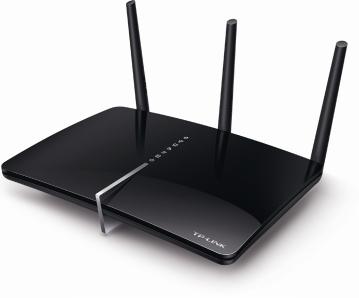
Chapter 1 |
Get to Know About Your Modem Router |
•Supports system log and flow Statistics.
•Supports firmware upgrade and Web management.
•Provides WPA-PSK/WPA2-PSK data security, TKIP/AES encryption security.
•Provides 64/128-bit WEP encryption security and wireless LAN ACL (Access Control List).
•Supports USB Storage Sharing, Print Server, FTP Server, Media Server.
•Supports Ethernet WAN (EWAN).
•Supports Bandwidth Control.
•Supports IPv6.
•Supports Guest Network.
1. 3. Panel Layout
1. 3. 1. Top View
The modem router’s LEDs are located on the top panel (View from top to bottom). You can check the modem router’s working status by following the LED Explanation table.
5

Chapter 1 Get to Know About Your Modem Router
|
|
|
LED Explanation |
|
|
|
|
|
|
|
Name |
Status |
Indication |
|
|
|
On |
A WPS synchronization is established. |
|
|
|
|
|
|
|
|
Flashing |
A wireless device is trying to connect to the network via WPS. |
|
|
WPS |
This process may take up to 3 minutes. |
||
|
|
|||
|
|
Off |
A WPS synchronization has been established for more than 5 |
|
|
|
minutes or a WPS synchronization failed. |
||
|
|
|
||
|
|
|
|
|
|
|
On |
The USB device is identified and ready to use. |
|
|
|
|
|
|
|
USB |
Flashing |
The USB device is being identified. |
|
|
|
Off |
No USB device is plugged into the USB port. |
|
|
|
|
|
|
|
LAN |
On |
At least one LAN port is connected. |
|
|
|
|
||
Off |
No LAN port is connected. |
|||
|
|
|||
|
|
|
|
|
|
Wireless |
On |
The wireless 2.4GHz or 5GHz band is enabled. |
|
|
|
|
||
Off |
The wireless function is disabled. |
|||
|
|
|||
|
|
|
|
|
|
|
On |
Internet connection is available. |
|
|
Internet |
|
|
|
|
Off |
No Internet connection or the modem router is operating in |
||
|
|
Bridge mode. |
||
|
|
|
||
|
|
|
|
|
|
|
On |
ADSL line is synchronized and ready to use. |
|
|
|
|
|
|
|
ADSL |
Flashing |
The ADSL negotiation is in progress. |
|
|
|
|
||
Off |
ADSL synchronization failed. Please refer to Note 1 for |
|||
|
|
|||
|
|
troubleshooting. |
||
|
|
|
||
|
|
|
|
|
|
Power |
On |
Power is on. |
|
|
|
|
||
Off |
Power is off. |
|||
|
||||
|
|
|||
|
|
|
|
 Note:
Note:
1.If the ADSL LED is off, please check your Internet connection first. Refer to Connect Your Modem Router for more information about how to make Internet connection correctly. If you have already made a right connection, please contact your ISP to make sure your Internet service is available now.
2.If the Internet LED is off, please check your ADSL LED first. If your ADSL LED is also off, please refer to Note 1. If your ADSL LED is ON, please check your Internet configuration. You may need to check this part of information with your ISP and make sure everything have been input correctly.
6

Chapter 1 |
Get to Know About Your Modem Router |
1. 3. 2. The Back Panel
The modem router’s back panel shows the connection ports, buttons and antennas. Refer to the following for detailed instructions.
Item |
Description |
|
|
|
|
|
For connecting the modem router to the Internet. Connect the port to the |
|
ADSL |
splitter or directly connect the port to the phone jack via a phone cable. For |
|
|
details, please refer to Connect the Modem Router. |
|
|
|
|
USB |
For connecting to a USB storage device or a USB printer. |
|
|
|
|
WPS |
The switch for the WPS function. |
|
|
|
|
WiFi ON/OFF |
For turning on/off the Wi-Fi function. |
|
|
|
|
|
The switch for the RESET function. There are two ways to reset the modem |
|
|
router’s factory defaults. |
|
|
Method one: With the modem router powered on, use a pin to press and hold |
|
RESET |
the RESET button on the rear panel of the modem router for 8 seconds until |
|
all LEDs turn off momentarily, then release the button. |
||
|
||
|
Method two: Log into the web management page of the modem router, and |
|
|
go to Advanced > System Tools > Backup & Restore, click Factory Restore and |
|
|
wait until the reset process is complete. |
|
|
|
|
LAN1, LAN2, LAN3, |
For connecting the modem router to your PC or other Ethernet network |
|
devices. In wireless router mode you will be able to connect to Cable/FTTH/ |
||
LAN4/WAN |
||
VDSL/ADSL devices. |
||
|
||
|
|
|
POWER ON/OFF |
The switch for the power. Press it to power on or off the modem router. |
|
|
|
|
POWER |
For connecting the modem router to power socket via the provided power |
|
adapter. |
||
|
||
|
|
|
Antennas |
Used for wireless operation and data transmit. Upright them for the best Wi-Fi |
|
performance. |
||
|
||
|
|
7

Chapter 2
Connect the Hardware
This chapter contains the following sections:
•Position Your Modem Router
•Connect Your Modem Router
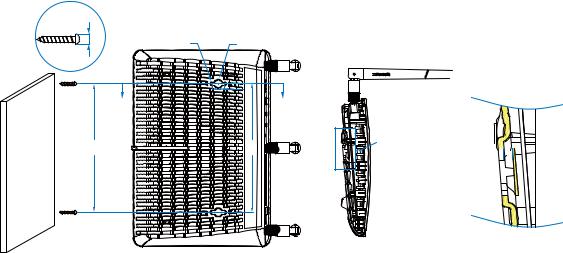
Chapter 2 |
Connect the Hardware |
2. 1. Position Your Modem Router
With the modem router, you can access your network from anywhere within the wireless network coverage. However, the wireless signal strength and coverage varies depending on the actual environment where your modem router is in. Many obstacles may limit the range of the wireless signal, for example, concrete structures, thickness and number of walls.
For your security and best Wi-Fi performance, please:
•Do Not locate the modem router in the place where it will be exposed to moisture or excessive heat.
•Keep away from the strong electromagnetic radiation and the device of electromagnetic sensitive.
•Place the modem router in a location where it can be connected to the various devices as well as to a power source.
•Make sure the cables and power cord are safely placed out of the way so they do not create a tripping hazard.
 Tips: The modem router can be placed on a shelf or desktop.
Tips: The modem router can be placed on a shelf or desktop.
Generally, the modem router is placed on a horizontal surface. The device can also be mounted on the wall as shown in the following picture.
ØD |
|
Φ4.1 |
Φ9.6 |
|
14 |
A |
A |
150 |
150 |
See detail B
4 






3.2


SECTION A-A |
detail B |
SCALE 3:1 |
 Note:
Note:
The diameter of the screw is between 4.1mm and 9.6mm, and the distance of two screws is 150mm. The screws that project from the wall need around 7mm based, and the length of the screw needs to be at least 25mm to withstand the weight of the product.
2. 2. Connect Your Modem Router
Follow the steps below to connect your modem router.
9
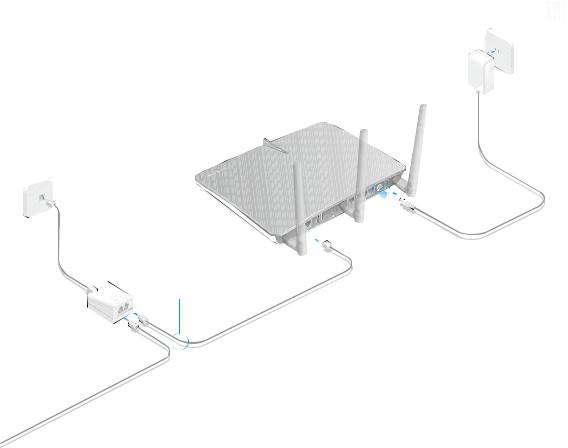
Chapter 2 |
Connect the Hardware |
1.Connect the ADSL line and power adapter. The electrical outlet shall be installed near the device and shall be easily accessible
wer Adapter
Modem
Phone Jack
t the ADSL splitter phone jack.
ADSL Splitter
(Optional)
2. Connect your computer to the modem router.
Method 1: Wired
Connect your computer’s Ethernet port to the LAN port on the modem router via the Ethernet cable.
Method 2: Wirelessly
Use the default SSID (Wireless Network Name) and Wireless Password printed on the product label of the modem router to connect wirelessly.
Method 3: Use the WPS button
Wireless devices that support WPS, including Android phones, tablets, most USB network cards, can be connected to your router through this method. (WPS is not supported by IOS devices.)
 Note:
Note:
The WPS function cannot be configured if the wireless function of the router is disabled. Also, the WPS function will be disabled if your wireless encryption is WEP. Please make sure the wireless function is enabled and is configured with the appropriate encryption before configuring the WPS.
1 ) Tab the WPS icon on the device’s screen.
10

Chapter 2 Connect the Hardware
2 ) |
Immediately press the WPS button on your modem router. |
||||||||||||||||||||||||||||
3 ) |
The WPS LED flashes for about 3 minutes during the WPS process. |
||||||||||||||||||||||||||||
4 ) |
When the WPS LED is on, the client device has successfully connected to the |
||||||||||||||||||||||||||||
|
modem router. |
||||||||||||||||||||||||||||
|
|
|
|
|
|
|
|
|
|
|
|
|
|
|
|
|
|
|
|
|
|
|
|
|
|
|
|
|
|
|
|
|
|
|
|
|
|
|
|
|
|
|
|
|
|
|
|
|
|
|
|
|
|
|
|
|
|
|
|
|
|
|
|
|
|
|
|
|
|
|
|
|
|
|
|
|
|
|
|
|
|
|
|
|
|
|
|
|
|
|
|
|
|
|
|
|
|
|
|
|
|
|
|
|
|
|
|
|
|
|
|
|
|
|
|
|
|
|
|
|
|
|
|
|
|
|
|
|
|
|
|
|
|
|
|
|
|
|
|
|
|
|
|
|
|
|
|
|
|
11

Chapter 3
Log into Your Modem Router
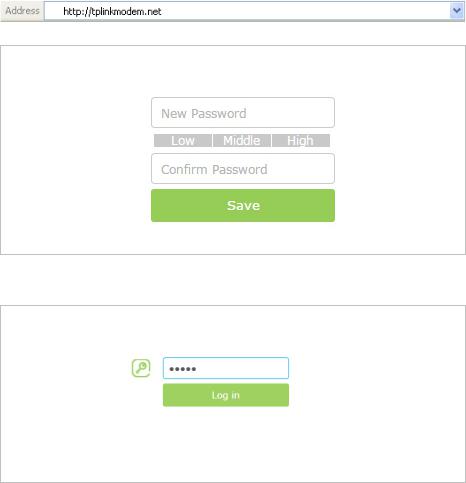
Chapter 3 |
Log into Your Modem Router |
With a Web-based utility, it is easy to configure and manage the modem router. The Web-based utility can be used on any Windows, Macintosh or UNIX OS with a Web browser, such as Microsoft Internet Explorer, Mozilla Firefox or Apple Safari.
Follow the steps below to log into your modem router.
1.If the TCP/IP Protocol on your computer is set to the static (fixed) IP address, you need to change it to obtain an IP address automatically.
2.Launch a web browser and type in http://tplinkmodem.net or http://192.168.1.1. Set a strong password using 1-15 characters and click Save.
3. Enter the password you set and click Login.
 Note: For subsequent logins, you only need to enter the password that you have set to log in.
Note: For subsequent logins, you only need to enter the password that you have set to log in.
13

Chapter 4
Set Up Internet
Connections
This chapter introduces how to connect your modem router to the Internet. The modem router is equipped with a web-based Quick Setup wizard. It has many ISP information built in, automates many of the steps and verifies that those steps have been successfully completed. Furthermore, you can also set up an IPv6 connection if your ISP provided IPv6 service.
This chapter includes the following sections:
•Use Quick Setup Wizard
•Manually Set up an Internet Connection
•Set up an IPv6 Connection
•Test Internet Connectivity

Chapter 4 |
Set Up Internet Connections |
4. 1. Use Quick Setup Wizard
To set up your modem router with several easy steps quickly:
1.Visit http://tplinkmodem.net, and log in with the password you set for the modem router.
2.Click Quick Setup, select your ISP from the dropdown list or select Other if you can’t find your ISP, then click Next.
3.Follow the on-screen instructions to complete the setup.
 Note:
Note:
1.During the quick setup process, you can change the preset wireless network name (SSID) and wireless password. Once done, all your wireless devices must use the new SSID and password to connect to the modem router.
2.The modem router supports two operation modes, DSL Modem Router Mode and Wireless Router mode. If you already have a modem or your Internet comes via an Ethernet cable from the wall, you can set up the modem router as a regular wireless router to share the Internet. Refer to Appendix B: Troubleshooting for details.
4. 2. Manually Set up an Internet Connection
To manually add an Internet connection without following the instructions of the Quick Setup wizard:
1.Visit http://tplinkmodem.net, and log in with the password you set for the modem router.
2.Go to Basic > Internet page. Select your ISP, and the VPI and VCI values will be automatically filled in. Enter the information provided by your ISP for the Connection Type. If you can’t find your ISP in the ISP List, select Other and then enter the information provided by your ISP.
15
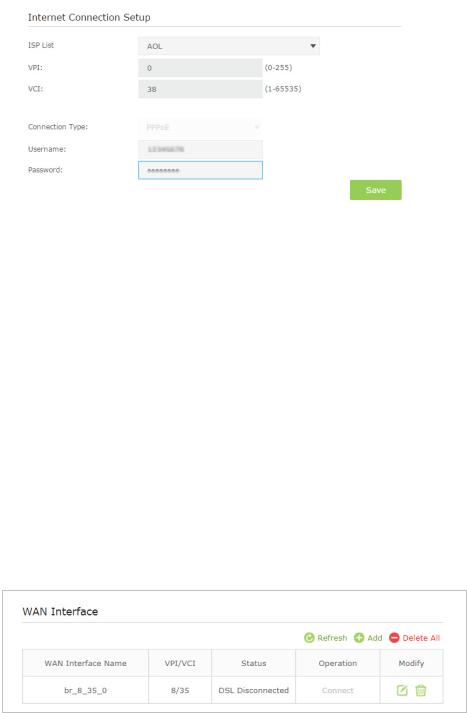
Chapter 4 |
Set Up Internet Connections |
||
|
|
|
|
|
|
|
|
3.Click Save to make the settings effective and you can refer to TestInternetConnectivity to test the Internet connection.
 Tips: You can view and edit all Internet connections on Advanced > Network > Internet page.
Tips: You can view and edit all Internet connections on Advanced > Network > Internet page.
4. 3. Set up an IPv6 Connection
If the DSL line your ISP provided also supports IPv6 connection and your ISP has provided some detailed IPv6 parameters, you can configure the modem router to permit IPv6 connection.
Follow the steps below to set up an IPv6 connection.
1.Configure the WAN settings.
1) Visit http://tplinkmodem.net, and log in with the password you set for the modem router.
2) Go to Advanced > Network > Internet page. Select your WAN Interface Name and click the  (Edit) icon.
(Edit) icon.
3 ) Scroll down to configure the IPv6 parameters.
16

Chapter 4 |
Set Up Internet Connections |
||
|
|
|
|
|
|
|
|
Select the checkbox to enable IPv6 feature.
Addressing Type: Consult your ISP for the addressing type, DHCPv6 or SLAAC. SLAAC is the most commonly used addressing type.
IPv6 Gateway: Keep the default setting as Current Connection.
 Note: If your ISP has provided the IPv6 address, click Advanced to reveal more settings. Check to use IPv6 specified by ISP and enter the parameters provided by your ISP.
Note: If your ISP has provided the IPv6 address, click Advanced to reveal more settings. Check to use IPv6 specified by ISP and enter the parameters provided by your ISP.
4 ) Click OK to make the settings effective.
2.Configure the IPv6 LAN settings. Go to Advanced > Network > LAN Settings page. Select IPv6 to configure IPv6 LAN parameters.
1 ) |
Select the Prefix Delegated WAN Connection, the IPv6 connection you just set |
|
up, from the drop-down list. |
2 ) |
Leave the rest of the settings as default. |
3 ) |
Click Save to make the settings effective. |
3.Done. IPv6 service is available for your network.
4.4. Test Internet Connectivity
After setting up the Internet connection, you need to know the Internet connectivity. The modem router provides a diagnostic tool to help you locate the malfunction.
17

Chapter 4 |
Set Up Internet Connections |
1.Visit http://tplinkmodem.net, and log in with the password you set for the modem router.
2.Go to Advanced > System Tools > Diagnostics page.
3.Click Start to test the Internet connectivity and you will see the test result in the gray box.
18

Chapter 5
Bandwidth Control
The Bandwidth Control feature is used to fully utilize your limited bandwidth and optimize the load respectively. With this feature enabled, you can assign a specific minimum or maximum bandwidth for each computer, thus minimizing the impact caused when the connection is under heavy load.
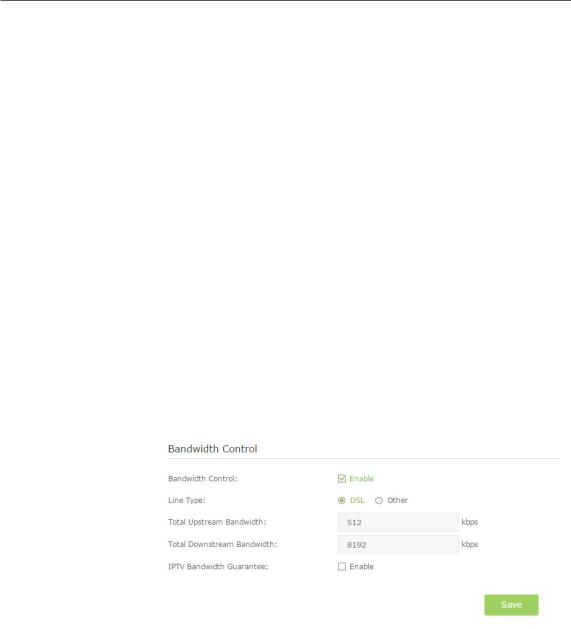
Chapter 5 Bandwidth Control
I want to: |
Use an independent bandwidth and enjoy a good Internet |
|
experience without being affected by other users who are |
|
sharing the same router. |
|
For example, my roommate and I share 512Kbps Upstream |
|
Bandwidth and 8Mbps Downstream Bandwidth via this router, |
|
she likes to watch live show and play online games, which may |
|
take up much bandwidth. I don’t want to be affected, so we |
|
agree to equally distribute the bandwidth. Our IP addresses are |
|
192.168.1.101 and 192.168.1.110. |
Tips: |
To use the bandwidth control feature, you’d better set static |
|
IP Address on each computer to be controlled or configure |
|
Address reservation on the modem router in order to manage |
|
easily. About how to configure address reservation, please refer |
|
to Reserve LAN IP Addresses. |
How can I |
1. Visit http://tplinkmodem.net, and log in with the password |
do that? |
you set for the modem router. |
|
2. Go to Advanced > Bandwidth Control page. |
|
|
|
|
3.Enable Bandwidth Control, choose DSL on the line type. If you don’t know how to choose the line type, please contact your ISP which line type you have access.
4.EntertheTotalUpstreamBandwidthandtheTotalDownstream Bandwidth given by your ISP. (1Mbps=1024Kbps). Click Save to save the settings.
5.Click Add to add controlling rules for each computer respectively.
20
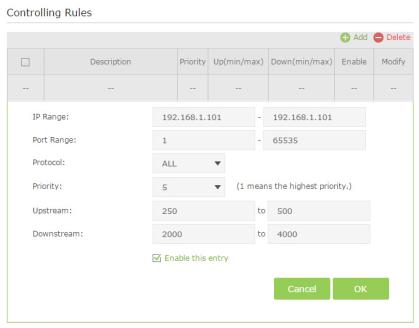
Chapter 5 |
Bandwidth Control |
|
|
|
|
1 ) IP Range: Enter the IP address. The field can be single IP address or IP address range according to your demands. When you configure the single IP address, the computer with this IP address will get independent given bandwidth. When you configure the IP address range, all computers in the range will share the given bandwidth.
2 ) Port Range: Keep the default settings. The default port range of TCP protocol or UDP protocol is from 1 to 65535.
3 ) Protocol: Keep the default setting. Or you can choose the TCP protocol or UDP protocol or both of them.
4 ) Priority: Keep the default setting. You can change the value if you want to first guarantee the bandwidth for one computer. The smaller value has the higher priority.
5 ) Upstream/Downstream: Enter the bandwidth according to your division.
6 ) Check to enable this entry and click OK to save the settings.
6.Follow the steps above to add a rule for the other computer. And then you will get the following table.
21

Chapter 5 |
Bandwidth Control |
|
|
|
|
Done! |
Now you and your roommate have an independent bandwidth. |
22

Chapter 6
Network Security
This chapter guides you on how to protect your home network from unauthorized users by implementing these three network security functions. You can block or allow specific client devices to access your wireless network using MAC Filtering, or using Access Control for wired and wireless networks, or you can prevent ARP spoofing and ARP attacks using IP & MAC Binding.
•MAC Filtering
•Access Control
•IP & MAC Binding
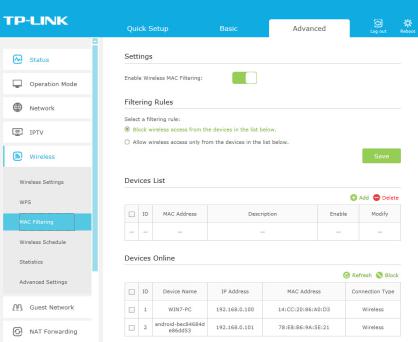
Chapter 6 |
Network Security |
6. 1. MAC Filtering
This function exploits the uniqueness of the MAC (Medium Access Control) address, a unique 12-digit hexadecimal address (for example, D8:5D:4C:B4:46:EA) of every network device, to determine if the device can or cannot access your wireless network.
I want to: |
Prevent unauthorized users from accessing my wireless network |
|
by utilizing the network device’s MAC address and IP address. |
|
For example, I have a computer that is connected to my wireless |
|
network. Now, an unknown device (an intruder) is also using my |
|
wireless network, which affects my Internet speed. I would like |
|
to control my wireless network with the following capabilities: |
|
• My computer is always allowed to access the wireless network. |
|
• The unknown device is not allowed to access the wireless |
|
network. |
|
• I don’t have to keep changing my wireless password as often. |
How can I |
1. Visit http://tplinkmodem.net, and log in with the password |
do that? |
you set for the router. |
|
2. Go to Advanced > Wireless > MAC Filtering and enable |
|
Wireless MAC Filtering. |
|
|
|
|
3.Select the filtering rule to either block (recommended) or allow the device(s) in the list.
24
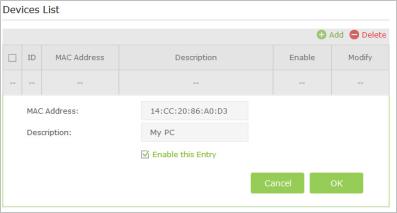
Chapter 6 |
Network Security |
To block specific device(s)
1 ) Select Block wireless access from the devices in the list below and click Save.
2 ) Select the device(s) to be blocked in the Devices Online table.
3 ) Click Block above the Devices Online table. The selected devices will be added to Devices List automatically.
To allow specific device(s)
1 ) Select Allow wireless access only from the devices in the list below and click Save.
2 ) Click Add.
|
3 ) Enter the MAC Address (You can copy and paste the MAC |
|
Address from Devices Online list if the device is connected |
|
to your wireless network) and enter the Description of |
|
the device. |
|
4 ) Select the checkbox to enable this entry, and click OK. |
Done! |
Now MAC Filtering is implemented to protect your wireless |
|
network. |
6. 2. Access Control
Access Control is used to block or allow specific client devices to access your network (via wired or wireless) based on a list of blocked devices (Blacklist) or a list of allowed devices (Whitelist).
I want to: |
Block or allow specific client devices to access my network (via |
|
wired or wireless). |
25

Chapter 6 Network Security
How can I |
1. |
Visit http://tplinkmodem.net, and log in with the password |
do that? |
|
you set for the router. |
|
2. |
Go to Advanced > Security > Access Control and enable |
|
|
Access Control. |
|
|
|
|
|
|
3.Select the access mode to either block (recommended) or allow the device(s) in the list.
To block specific device(s)
1 ) Select Blacklist and click Save.
2 ) Select the device(s) to be blocked in the Devices Online table.
3 ) Click Block above the Devices Online table. The selected devices will be added to Devices in Blacklist automatically.
To allow specific device(s)
1 ) Select Whitelist and click Save.
2 ) Click Add.
26
